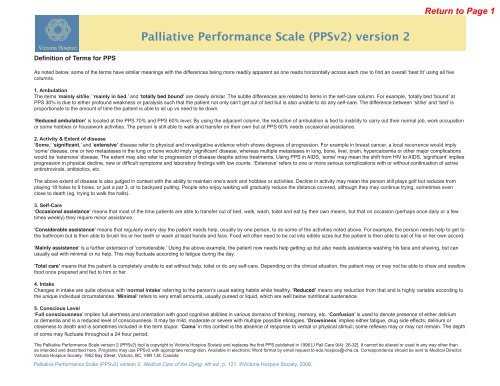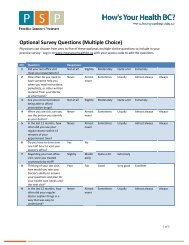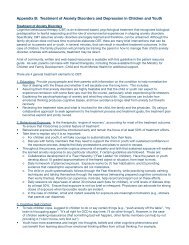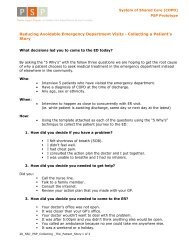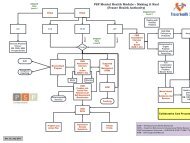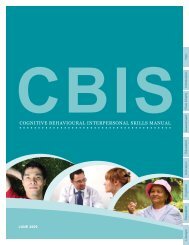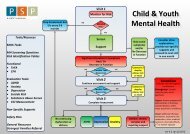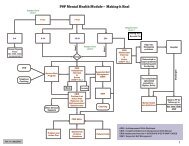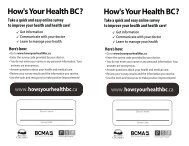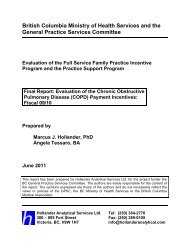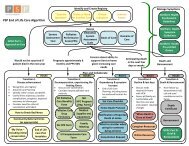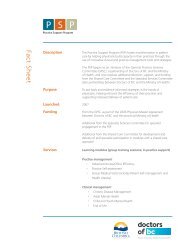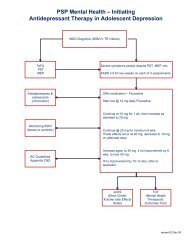PSP End of Life Care Algorithm - GPSC
PSP End of Life Care Algorithm - GPSC
PSP End of Life Care Algorithm - GPSC
Create successful ePaper yourself
Turn your PDF publications into a flip-book with our unique Google optimized e-Paper software.
Victoria HospiceDefinition <strong>of</strong> Terms for P<strong>PSP</strong>alliative Performance Scale (PPSv2) version 2As noted below, some <strong>of</strong> the terms have similar meanings with the differences being more readily apparent as one reads horizontally across each row to find an overall ‘best fit’ using all fivecolumns.1. AmbulationThe items ‘mainly sit/lie,’ ‘mainly in bed,’ and ‘totally bed bound’ are clearly similar. The subtle differences are related to items in the self-care column. For example, ‘totally bed ‘bound’ atPPS 30% is due to either pr<strong>of</strong>ound weakness or paralysis such that the patient not only can’t get out <strong>of</strong> bed but is also unable to do any self-care. The difference between ‘sit/lie’ and ‘bed’ isproportionate to the amount <strong>of</strong> time the patient is able to sit up vs need to lie down.‘Reduced ambulation’ is located at the PPS 70% and PPS 60% level. By using the adjacent column, the reduction <strong>of</strong> ambulation is tied to inability to carry out their normal job, work occupationor some hobbies or housework activities. The person is still able to walk and transfer on their own but at PPS 60% needs occasional assistance.2. Activity & Extent <strong>of</strong> disease‘Some,’ ‘significant,’ and ‘extensive’ disease refer to physical and investigative evidence which shows degrees <strong>of</strong> progression. For example in breast cancer, a local recurrence would imply‘some’ disease, one or two metastases in the lung or bone would imply ‘significant’ disease, whereas multiple metastases in lung, bone, liver, brain, hypercalcemia or other major complicationswould be ‘extensive’ disease. The extent may also refer to progression <strong>of</strong> disease despite active treatments. Using PPS in AIDS, ‘some’ may mean the shift from HIV to AIDS, ‘significant’ impliesprogression in physical decline, new or difficult symptoms and laboratory findings with low counts. ‘Extensive’ refers to one or more serious complications with or without continuation <strong>of</strong> activeantiretrovirals, antibiotics, etc.The above extent <strong>of</strong> disease is also judged in context with the ability to maintain one’s work and hobbies or activities. Decline in activity may mean the person still plays golf but reduces fromplaying 18 holes to 9 holes, or just a par 3, or to backyard putting. People who enjoy walking will gradually reduce the distance covered, although they may continue trying, sometimes evenclose to death (eg. trying to walk the halls).3. Self-<strong>Care</strong>‘Occasional assistance’ means that most <strong>of</strong> the time patients are able to transfer out <strong>of</strong> bed, walk, wash, toilet and eat by their own means, but that on occasion (perhaps once daily or a fewtimes weekly) they require minor assistance.‘Considerable assistance’ means that regularly every day the patient needs help, usually by one person, to do some <strong>of</strong> the activities noted above. For example, the person needs help to get tothe bathroom but is then able to brush his or her teeth or wash at least hands and face. Food will <strong>of</strong>ten need to be cut into edible sizes but the patient is then able to eat <strong>of</strong> his or her own accord.‘Mainly assistance’ is a further extension <strong>of</strong> ‘considerable.’ Using the above example, the patient now needs help getting up but also needs assistance washing his face and shaving, but canusually eat with minimal or no help. This may fluctuate according to fatigue during the day.‘Total care’ means that the patient is completely unable to eat without help, toilet or do any self-care. Depending on the clinical situation, the patient may or may not be able to chew and swallowfood once prepared and fed to him or her.4. IntakeChanges in intake are quite obvious with ‘normal intake’ referring to the person’s usual eating habits while healthy. ‘Reduced’ means any reduction from that and is highly variable according tothe unique individual circumstances. ‘Minimal’ refers to very small amounts, usually pureed or liquid, which are well below nutritional sustenance.5. Conscious Level‘Full consciousness’ implies full alertness and orientation with good cognitive abilities in various domains <strong>of</strong> thinking, memory, etc. ‘Confusion’ is used to denote presence <strong>of</strong> either deliriumor dementia and is a reduced level <strong>of</strong> consciousness. It may be mild, moderate or severe with multiple possible etiologies. ‘Drowsiness’ implies either fatigue, drug side effects, delirium orcloseness to death and is sometimes included in the term stupor. ‘Coma’ in this context is the absence <strong>of</strong> response to verbal or physical stimuli; some reflexes may or may not remain. The depth<strong>of</strong> coma may fluctuate throughout a 24 hour period.The Palliative Performance Scale version 2 (PPSv2) tool is copyright to Victoria Hospice Society and replaces the first PPS published in 1996 [J Pall <strong>Care</strong> 9(4): 26-32]. It cannot be altered or used in any way other thanas intended and described here. Programs may use PPSv2 with appropriate recognition. Available in electronic Word format by email request to edu.hospice@viha.ca. Correspondence should be sent to Medical Director,Victoria Hospice Society, 1952 Bay Street, Victoria, BC, V8R 1J8, CanadaPalliative Performance Scale (PPSv2) version 2. Medical <strong>Care</strong> <strong>of</strong> the Dying, 4th ed.; p. 121. ©Victoria Hospice Society, 2006.


